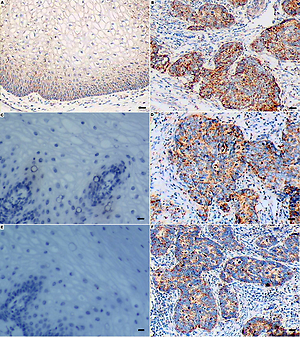Current issue
Archive
Manuscripts accepted
About the Journal
Editorial office
Editorial board
Section Editors
Abstracting and indexing
Subscription
Contact
Ethical standards and procedures
Most read articles
Instructions for authors
Article Processing Charge (APC)
Regulations of paying article processing charge (APC)
ONCOLOGICAL GYNECOLOGY / RESEARCH PAPER
Up-regulation of peroxiredoxin 3 by high-risk human papillomavirus in cervical cancer cells
1
Yantai Affiliated Hospital of Binzhou Medical University, China
2
Binzhou Medical University, China
Submission date: 2020-04-16
Final revision date: 2020-07-19
Acceptance date: 2020-08-02
Online publication date: 2021-04-18
KEYWORDS
TOPICS
ABSTRACT
Introduction:
Peroxiredoxin 3 (PRX3) is a member of PRX family with antioxidant functions by scavenging hydrogen peroxide. Since the development of cervical cancer is causally linked to high-risk human papillomavirus (HPV) that induces oxidative stress, we conducted the present study to investigate the response of PRX3 to high-risk HPV infection.
Material and methods:
This study included fifty-six patients with invasive squamous cervical cancer and sixty control patients with hysteromyoma. Enzyme-linked immunosorbent assay was performed to detect cervical oxidative stress and serum PRX3. The expression of PRX3 and oncoprotein E6 of HPV16 or HPV18 was examined in cervical cancer tissues by immunohistochemistry. Western Blot was applied to detect the expression of PRX3 and E6 in cervical cancer cell lines including CaSki, HeLa, and C33A.
Results:
Patients with cervical cancer showed higher serum PRX3 than control patients with hysteromyoma. Levels of oxidative markers in cervical cancer tissues were elevated as compared to normal cervical epithelia. PRX3 expression was upregulated in cervical cancer tissues and the upregulation was positively associated with the expression of E6 of HPV16 or HPV18. The association was confirmed in HPV-containing cervical cancer cell lines including CaSki and HeLa.
Conclusions:
Our results indicated a positive response of PRX3 to HPV-induced oxidative stress. Serum PRX3 might be a potential indicator of active amplification of high-risk HPV in cervical cancer cells.
Peroxiredoxin 3 (PRX3) is a member of PRX family with antioxidant functions by scavenging hydrogen peroxide. Since the development of cervical cancer is causally linked to high-risk human papillomavirus (HPV) that induces oxidative stress, we conducted the present study to investigate the response of PRX3 to high-risk HPV infection.
Material and methods:
This study included fifty-six patients with invasive squamous cervical cancer and sixty control patients with hysteromyoma. Enzyme-linked immunosorbent assay was performed to detect cervical oxidative stress and serum PRX3. The expression of PRX3 and oncoprotein E6 of HPV16 or HPV18 was examined in cervical cancer tissues by immunohistochemistry. Western Blot was applied to detect the expression of PRX3 and E6 in cervical cancer cell lines including CaSki, HeLa, and C33A.
Results:
Patients with cervical cancer showed higher serum PRX3 than control patients with hysteromyoma. Levels of oxidative markers in cervical cancer tissues were elevated as compared to normal cervical epithelia. PRX3 expression was upregulated in cervical cancer tissues and the upregulation was positively associated with the expression of E6 of HPV16 or HPV18. The association was confirmed in HPV-containing cervical cancer cell lines including CaSki and HeLa.
Conclusions:
Our results indicated a positive response of PRX3 to HPV-induced oxidative stress. Serum PRX3 might be a potential indicator of active amplification of high-risk HPV in cervical cancer cells.
Share
RELATED ARTICLE
We process personal data collected when visiting the website. The function of obtaining information about users and their behavior is carried out by voluntarily entered information in forms and saving cookies in end devices. Data, including cookies, are used to provide services, improve the user experience and to analyze the traffic in accordance with the Privacy policy. Data are also collected and processed by Google Analytics tool (more).
You can change cookies settings in your browser. Restricted use of cookies in the browser configuration may affect some functionalities of the website.
You can change cookies settings in your browser. Restricted use of cookies in the browser configuration may affect some functionalities of the website.



